converting – refining – toll converting
Send us your inquiry.
Do you have questions or need individual advice? Our team is at your disposal. Contact us and learn more about our tailored solutions in film converting.
Glossary of film converting at Pütz Folien
Below you will find clearly presented explanations of technical terms related to film converting. The explanations are based on industry standards, but with a direct practical relevance to film converting.
General processing terms at Pütz Folien
Converting
Summary of various processing steps for plastics (e.g., made from PET, PP, PVC, PI, acetate). Typical work steps include cutting rolls into formats, slitting and winding rolls, and packaging – at Pütz Folien, this includes, for example, rolls, cut-to-size material (sheets), and Spools technique.
Roll goods
Slitting / rewinding / winding to specific widths, lengths, or roll diameters.
Cut-to-size material (sheets)
Cut, rectangular or defined film pieces produced to customer specifications – ideal for direct consumption or further processing.
Spools technique
Winding method where film is wound diagonally overlapping – ensures uniform tension and better further processing on machines.
Finishing techniques
Printing
Refining by applying motifs or text to films using flexo, screen, gravure, or digital printing through partner companies – enables durable, UV- and chemical-resistant designs.
Lamination
Bonding technique in which multiple film layers or film and material are joined with adhesive to optimize stability, protection, and functionality.
Surface finishing
Refining the film surface, for example, through coating or texturing – serves to improve optics, haptics, or functional properties.
Orange peel effect
The “Orange Peel Effect” refers to an undesirable, irregular surface structure of films that visually resembles the skin of an orange. It occurs when the surface is not completely smooth but shows microscopic irregularities.
- Relevance in film converting: impairs transparency, print quality, and finishing.
- Consequences: haziness, poorer color acceptance, limitations in coatings.
- Avoidance: through highly transparent special films such as Super Clear PET (e.g., Type 41.31), optimized production parameters, and special surface treatments.
Avoiding the Orange Peel Effect is particularly important for optically demanding applications such as displays, coatings, or premium packaging.
Material & substrates
Substrate
Base material of a film, such as PET, PP, PVC, polyimides (e.g., polyester), or other special films.
Brand name
A brand name such as Hostaphan®, Kapton®, or Melinex® refers to special film products from a manufacturer that can be clearly assigned to a specific source, formulation, and quality standard by their name (® – Registered Trademark symbol).
Upilex®
High-performance polyimide film with extreme heat resistance up to approx. 400 °C, high mechanical stability, chemical resistance, and electrical insulation – used, for example, in electronics or aerospace.
Technical properties & processes
Coextrusion
Process for producing multi-layer films through simultaneous extrusion of different layers – enables targeted combination of properties.
Biaxially oriented
Mechanical orientation of the film in two directions (longitudinal and transverse), to increase strength, impact resistance, and dimensional stability.
Monoaxially oriented
Orientation in only one direction – often to increase longitudinal strength, e.g., in monoaxially oriented PP films.
Μm (micrometer)
Unit of measurement for specifying film thickness – 1 µm = 0.001 mm. Typical film thicknesses range from a few micrometers to several hundred µm.
Functional requirements
Heat resistance
Ability of the film to withstand high temperatures – important, for example, with Upilex®; relevant for applications such as hot stamping or thermoforming.
UV protection
Protection against UV radiation to prevent aging and discoloration – particularly important for outdoor applications and light protection.
Hydrolysis resistance
Resistance to chemical degradation by water – crucial for humid or wet-stressed applications.
Bio-based films
Films made from bio-based or biodegradable materials, such as PLA or cellulose acetate – offer a sustainable alternative to classic plastic film.
Special film types
Film with PCR content
Recycled film with post-consumer recycled content – ecological through recycling.
Release film
Release film or cover film that facilitates the detachment or protection of sensitive surfaces – e.g., in packaging or for adhesive protection.
Processing methods
Film production
Basic processes such as extrusion, calendering, or casting, with or without coextrusion – to produce the raw film.
Thermoforming
Heating the film and forming it over a mold – e.g., for packaging trays or technical applications.
Toll converting
External or customer-specific cutting service – films are cut to customer dimensions, e.g., as a cutting service.
